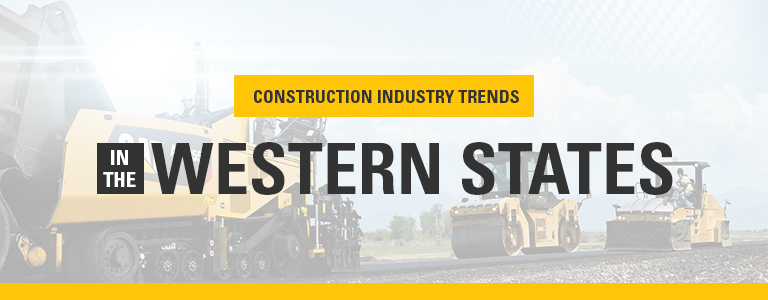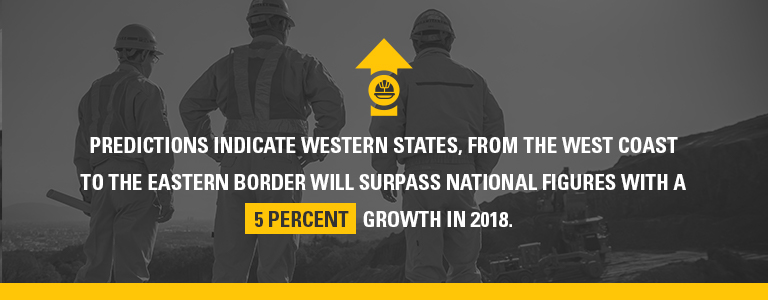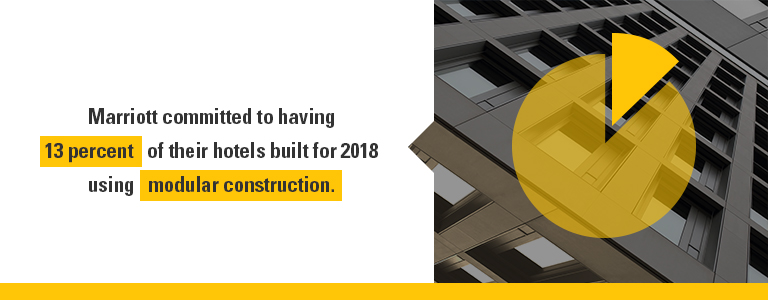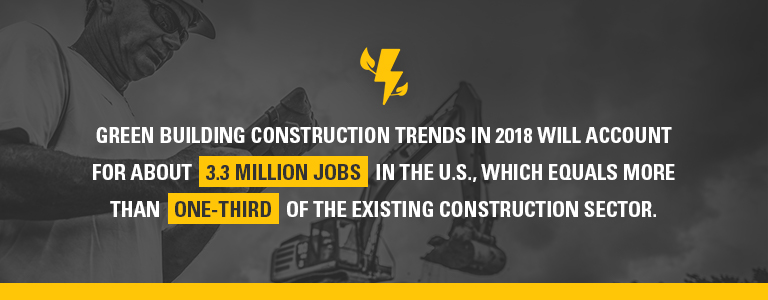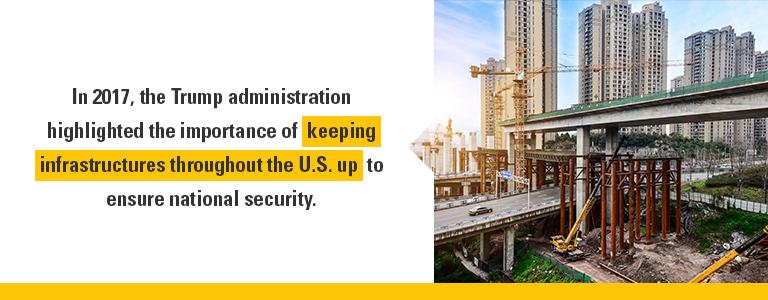Construction Industry Trends in the Western States
After closing 2017 on a high note, commercial construction companies are anticipating an even more robust 2018. As we look ahead into what will shape the construction industry trends this year, we can already see several themes emerging. Some represent an evolution from years past — such as modular construction and sustainable design — while some trends are new, such as a focus on resiliency following the costliest year on record for climate-related disasters.
2018 Construction Industry Trends in the United States
North American construction industry trend reports agree the total dollar amount invested in U.S. construction will grow 5 percent in 2018. The types of projects will include a 4 percent increase in non-residential construction, and single-family homes will see the most growth, with 9 percent.
When you divide the country regionally, the South and West are likely to experience the most growth in 2018, with a 5 and 6 percent increase, respectively. The West is expected to be the top-performing region in the U.S for construction in 2018, which is good news for construction contractors in Idaho and surrounding states. Predictions indicate Western states, from the West Coast to the eastern border of states such as Montana, Wyoming, Colorado, and New Mexico, will surpass national figures with a 5 percent growth in 2018 — with single-family and infrastructure construction predicted to grow by more than 6 percent altogether.
Overall, the construction industry trends will continue to grow in 2018, but its development will be slower, compared to previous years. It will be more of a slow and steady increase, rather than the explosive progress between 2012 and 2015. An estimate of 2 to 3 percent growth for non-residential buildings between 2018 and 2021 exists, while statistics also show an overall 5 percent increase in 2018 and 4 to 5 percent between 2019 and 2021.
In 2017, there was a labor shortage that’s also predicted to continue to hit the U.S. construction industry in 2018. According to a survey by the Associated General Contractors of America in 2017, 73 percent of construction companies nationwide planned to add jobs. However, the report projects that about 42 percent of Western states will continue to have difficulty filling salaried positions, and may need to reevaluate their recruitment strategies.
The Associated General Contractors of America survey also noted worker shortages are a problem for 54 percent of construction companies within the Pacific and Mountain time zones, and 47 percent are worried about worker quality. The statistics also showed 54 percent of construction companies in Western states had to increase benefits or pay to retain employees. While a shortage of trained workers will continue, the job growth outlook for construction equipment operators over the next decade is 12 percent, according to the Bureau of Labor Statistics.
Knowing the forecasted trends for 2018 and what occurred in 2017 can give you an idea of what to expect for the forthcoming year and how to use it to your advantage.
Offsite Construction: Modular and Prefabrication
Offsite and modular construction industry trends provide a faster way to develop and build residential areas. Construction companies work offsite, which not only reduces the amount of impact to the original landscape but also benefits contractors and their employees with a safer working environment.
Because the industry has been experiencing labor shortages, modular and prefabrication can help mitigate labor issues by requiring a smaller labor force to complete projects. It’s an innovative way to lower construction costs and reduce the necessity for additional workers while enhancing profits.
Constructing homes and buildings offsite means you and your team are in a more controlled environment — often using an assembly line. The most prominent draw toward the trend is when you have condensed and aggressive schedules. When you have shorter build times and need to jumpstart productivity, it’s cheaper to build modular homes offsite. Modular construction is finding its way into mainstream construction trends, as it also opens the door to greater collaboration between contractors and offsite fabricators.
In 2018, it will be common to see suppliers develop specialty lines specific for offsite construction, which helps streamline overall operations. Some may even offer clients the option to move their home on a semi-truck to transport it from city to city.
To give you an idea of how much the offsite trend is taking off, Marriott committed to having 13 percent of their hotels built for 2018 using modular construction. To put this in perspective, Marriott will prefabricate at least 50 hotels offsite, which will avoid delays due to weather, while also reducing safety hazards and labor costs onsite.
Green and Sustainable Infrastructure Projects
Green and sustainable buildings are not new. In fact, “going green” has been a long-foreseen trend that continues to grow with various forms of technology. In 2018, industry experts such as Green Building Education Services predict it will continue to flourish as construction companies implement different tactics.
Green roofs will become a standard feature within urban regions, as well as recycling construction waste. As opposed to throwing material in landfills, waste from demolition and renovation projects will fill recycling sites. It can create a positive impact on the environment, as well as on other industries. For example, recycling sites can crush concrete and use it as an aggregate for roads.
In 2018, you will also see a significant push toward renewable sources of energy, whether it’s wind, solar, hydro, or geothermal construction projects. Innovative technologies are finding ways to use naturally occurring sources of energy to either support the construction process or implement it in homes and buildings.
Green building construction trends in 2018 will account for about 3.3 million jobs in the U.S., which equals more than one-third of the existing construction sector. It’s also expected to generate $190.3 billion in labor profits.
Resilience to Natural Disasters
No one is immune to natural disasters, whether you live on the West Coast, East Coast, or somewhere in between. While many people recognize the construction industry trends play a role in post-disaster efforts, it’s becoming more apparent they play a much more significant part than rebuilding communities. As an owner or manager of a construction business, your efforts can help mitigate both property loss and the loss of human life after these devastating events.
You can prepare for natural disasters by partnering with organizations that specialize in designing structures to withstand the violent forces of nature. It’s vital to research how buildings withstand certain storms by looking at the material you use. Construction companies can team up with organizations that implement tests, such as The Wood Truss Council of America’s Structural Building Components Research Institute.
The center duplicates the effects of severe weather on materials by mimicking wind, snow, rain, etc. To make sure you are using appropriate materials to withstand conditions, partner with a materials testing company. You can include their methods to assist in preparing for future natural disasters by protecting buildings.
Disaster resilience is a trend in the construction industry, where a need for partnerships between private sectors and insurance loss prevention experts exist as well. Together, everyone can calculate detailed risks, conclude how to attain resiliency, and reduce the effects of natural disasters.
“As we continue to produce information about the benefits of resilience,” said Ryan Colker of the National Institute of Building Sciences, “I think you can see an increased recognition from builders that people are willing to pay for this. There’s the value associated with it.”
During any devastation, construction companies outside the disaster zone are more likely to help, as those in the middle of a catastrophe will need to follow safety procedures. Many businesses have a license to perform disaster relief efforts where FEMA will reach out to you for support.
After a severe tragedy strikes, construction company efforts of recovery and reconstruction are crucial. Your job is to improve buildings to withstand future occurrences, as well as maintain and enhance previous infrastructures. Your ability to adapt to various situations is vital in making a difference.
Instead of duplicating replacement buildings, many companies will create resilient sites and features. In 2017, the Trump administration highlighted the importance of keeping infrastructures throughout the U.S. up to ensure national security. Other projects for the future may include raising streets and building earthquake-resilient skyscrapers.
Listening to the community is imperative as you begin your final decision-making. You will want to reconstruct naturally, instead of commanding an outside vision on an area. Here is where you can plan for future events with preventive measures in place and also try different housing models. Partnerships with communities and other organizations can be beneficial, too.
While natural tragedies like hurricanes, wildfires, floods, earthquakes, and tornadoes destroy regions of our country, they often also result in economic prosperity. Because the need for reconstruction is vital, it leads to a boom in infrastructure and home construction. Events even promote the creation of updated and improved buildings, which results in long-term economic advantages. Rebuilding areas offer developments by bringing in assets to the specific region.
How Winners Establish a Competitive Advantage in the Construction Industry in 2018
Technology trends in construction for 2018 can mean the difference between a mediocre and a superior construction company. Investing in the right technology can help you succeed and gain a competitive advantage, as well as increase your company’s security, mobility, productivity, and efficiency. If you want results to show excellent profits, consider the following advancements and trends.
- 3D printing: 3D printing technology gives you the ability to develop prototypes and accurate replicas of a project that can help you make quick changes for your clients. You can craft custom parts on-demand and save time. 3D printing has developed innovative projects, including Europe’s first 3D-printed building.
- Building information modeling: BIM has 6D technology that results in faster construction and promotes a safer building process to reduce construction costs. If you want to know about any issues you may face beforehand, you can increase the effectiveness and collaboration of your projects.
- Cloud applications: Investing in mobile devices with cloud applications can enable your workers to transfer, access, and save information for exceptional security, recovery, and backup—particularly if you need to store sensitive data.
- Design-build process: When collaboration and communication are imperative, use integrated project delivery as a device to help solve schedule delays. If you can’t meet schedules, or owners ask you for earlier completion dates, it can assist you with better planning.
- Drones: Drones can access remote locations, track assets, collect data, complete safety inspections, conduct effective surveillance, capture project progress, and much more. Drones and unmanned aerial vehicles — UAVs — create 3D mapping and images that can depict areas that are otherwise difficult to examine on foot. They also deliver visuals of your project’s progression in real-time.
- Fleet management: Fleet management technology can help keep costs down while streamlining and improving operations.
- Improvements in safety: Because construction sites are one of the most accident-prone areas, owners are always searching for safety improvements such as virtual reality programs and drones. VR can help your workers train before using heavy equipment, and drones can inspect areas for danger.
- Job mapping: Job site mapping tools are invaluable for helping your company plan any project and meet deadlines throughout the process.
- Private-public partnerships: Because material costs will continue to rise in 2018, you need to act fast to secure stable prices with your vendors. It’s a way to obtain financing approval and finish projects that aren’t always possible. Some even bundle work with other contractors to get better pricing.
- Staying green: Environmental awareness isn’t just a fad — it’s an expectation within the construction industry to increase green design participation. You can use sustainable products, recycle, reuse and rethink approaches to daily activities to help you aim toward LEED certification.
- The Internet of Things: It’s vital to stay connected and keep up with technology construction trends, whether you have a smartphone, GPS, tablet, or other mobile devices. You must learn to increase your productivity with collaboration, photos, documents, logistics, data, time tracking, and inventory abilities which can result in quicker production and greater scalability.
- Wearable devices: Smartwatches and other devices can monitor workers and notify them when they are overdue to take a break, which can reduce the chance of injuries and increase productivity. GPS tracking in specific systems can also help supervisors know where teams are in case of emergencies.
With new forms of technology hitting the construction world, your business can not only benefit from increased productivity and controlled maintenance of your heavy equipment, but you can develop superior safety measures. Safety and efficiency are the two most important factors for success in the construction industry. But with more technological advancements reaching the market, the industry will continue to improve.
Smartphones, tablets, and computers can send messages, data, and alerts through the Internet, while VR allows you to simulate projects to show your clients. Augmented reality modeling aids you in seeing how something looks before construction, which can prevent costly mistakes. All these and so many more technologies can advance your fleet of heavy equipment, maintenance schedules, and business as a whole.
Choosing a Heavy Equipment Partner in 2018
As 2018 construction trends reach your business, you will need to rely on the right heavy equipment partner to help you keep up and gain a competitive advantage. Sounds weird You will also want to search for scalability and find a company that can provide you the resources to get your projects done. Western States CAT has experienced service technicians who commit themselves to your long-term success. They receive ongoing training for machines and technology to remain reliable and responsive whenever you need them. We are innovative to the core to make you more sustainable and respond to any changes you may go through.
Western States CAT
Sign up for more industry insights from the leader in heavy equipment sales and service in the West. Contact Western States CAT online.
